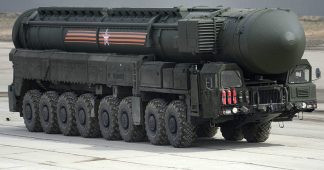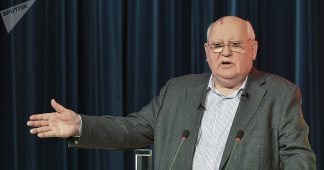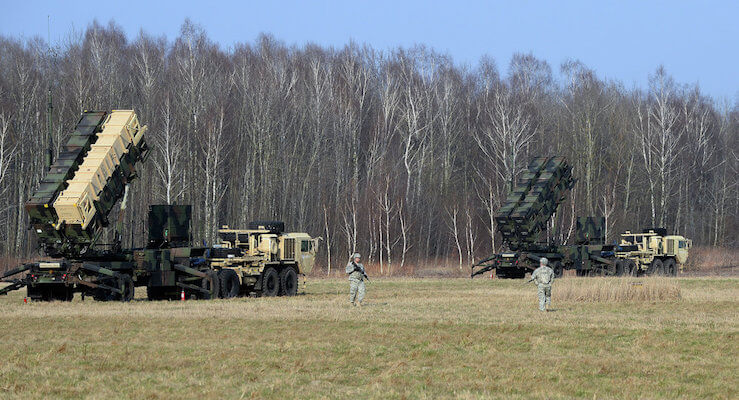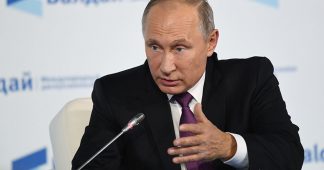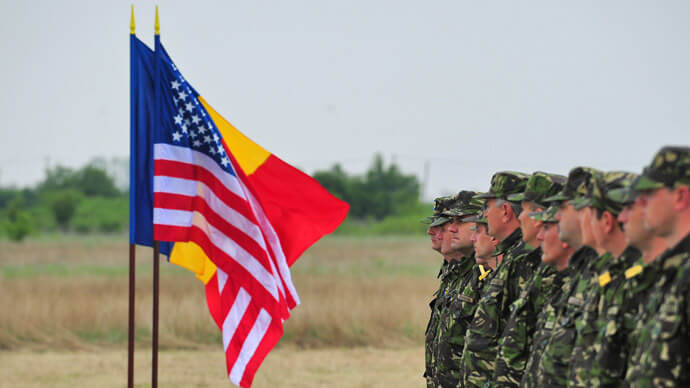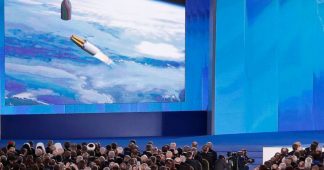We reproduce here the part of the Russian President recent speech dealing with the East-West Relations and Nuclear Arms policy of his country. You may read the whole speech at Presidential Address to the Federal Assembly
Vladimir Putin has explained the measures adopted by Moscow as a response to the withdrawal of the United States from the ABM Treaty, including the development of new weapons, which are, as he described them, unique in the world, as far as their velocity is concerned and completely impossible to intercept them by any antiballistic system.
Speaking about the nuclear doctrine of his country, Mr. Putin said the following:
“I should note that our military doctrine says Russia reserves the right to use nuclear weapons solely in response to a nuclear attack, or an attack with other weapons of mass destruction against the country or its allies, or an act of aggression against us with the use of conventional weapons that threaten the very existence of the state. This all is very clear and specific.
As such, I see it is my duty to announce the following. Any use of nuclear weapons against Russia or its allies, weapons of short, medium or any range at all, will be considered as a nuclear attack on this country. Retaliation will be immediate, with all the attendant consequences”.
Here is all the relevant part of Mr. Putin’s speech:
I will speak about the newest systems of Russian strategic weapons that we are creating in response to the unilateral withdrawal of the United States of America from the Anti-Ballistic Missile Treaty and the practical deployment of their missile defence systems both in the US and beyond their national borders.
¨
I would like to make a short journey into the recent past.
Back in 2000, the US announced its withdrawal from the Anti-Ballistic Missile Treaty. Russia was categorically against this. We saw the Soviet-US ABM Treaty signed in 1972 as the cornerstone of the international security system. Under this treaty, the parties had the right to deploy ballistic missile defence systems only in one of its regions. Russia deployed these systems around Moscow, and the US around its Grand Forks land-based ICBM base.
Together with the Strategic Arms Reduction Treaty, the ABM Treaty not only created an atmosphere of trust but also prevented either party from recklessly using nuclear weapons, which would have endangered humankind, because the limited number of ballistic missile defence systems made the potential aggressor vulnerable to a response strike.
We did our best to dissuade the Americans from withdrawing from the treaty. All in vain. The US pulled out of the treaty in 2002. Even after that we tried to develop constructive dialogue with the Americans. We proposed working together in this area to ease concerns and maintain the atmosphere of trust. At one point, I thought that a compromise was possible, but this was not to be. All our proposals, absolutely all of them, were rejected. And then we said that we would have to improve our modern strike systems to protect our security. In reply, the US said that it is not creating a global BMD system against Russia, which is free to do as it pleases, and that the US will presume that our actions are not spearheaded against the US.
The reasons behind this position are obvious. After the collapse of the USSR, Russia, which was known as the Soviet Union or Soviet Russia abroad, lost 23.8 percent of its national territory, 48.5 percent of its population, 41 of the GDP, 39.4 percent of its industrial potential (nearly half of our potential, I would underscore), as well as 44.6 percent of its military capability due to the division of the Soviet Armed Forces among the former Soviet republics. The military equipment of the Russian army was becoming obsolete, and the Armed Forces were in a sorry state. A civil war was raging in the Caucasus, and US inspectors oversaw the operation of our leading uranium enrichment plants.
For a certain time, the question was not whether we would be able to develop a strategic weapon system – some wondered if our country would even be able to safely store and maintain the nuclear weapons that we inherited after the collapse of the USSR. Russia had outstanding debts, its economy could not function without loans from the IMF and the World Bank; the social sphere was impossible to sustain.
Apparently, our partners got the impression that it was impossible in the foreseeable historical perspective for our country to revive its economy, industry, defence industry and Armed Forces to levels supporting the necessary strategic potential. And if that is the case, there is no point in reckoning with Russia’s opinion, it is necessary to further pursue ultimate unilateral military advantage in order to dictate the terms in every sphere in the future.
Basically, this position, this logic, judging from the realities of that period, is understandable, and we ourselves are to blame. All these years, the entire 15 years since the withdrawal of the United States from the Anti-Ballistic Missile Treaty, we have consistently tried to reengage the American side in serious discussions, in reaching agreements in the sphere of strategic stability.
We managed to accomplish some of these goals. In 2010, Russia and the US signed the New START treaty, containing measures for the further reduction and limitation of strategic offensive arms. However, in light of the plans to build a global anti-ballistic missile system, which are still being carried out today, all agreements signed within the framework of New START are now gradually being devaluated, because while the number of carriers and weapons is being reduced, one of the parties, namely, the US, is permitting constant, uncontrolled growth of the number of anti-ballistic missiles, improving their quality, and creating new missile launching areas. If we do not do something, eventually this will result in the complete devaluation of Russia’s nuclear potential. Meaning that all of our missiles could simply be intercepted.
Despite our numerous protests and pleas, the American machine has been set into motion, the conveyer belt is moving forward. There are new missile defence systems installed in Alaska and California; as a result of NATO’s expansion to the east, two new missile defence areas were created in Western Europe: one has already been created in Romania, while the deployment of the system in Poland is now almost complete. Their range will keep increasing; new launching areas are to be created in Japan and South Korea. The US global missile defence system also includes five cruisers and 30 destroyers, which, as far as we know, have been deployed to regions in close proximity to Russia’s borders. I am not exaggerating in the least; and this work proceeds apace.
So, what have we done, apart from protesting and warning? How will Russia respond to this challenge? This is how.
During all these years since the unilateral US withdrawal from the ABM Treaty, we have been working intensively on advanced equipment and arms, which allowed us to make a breakthrough in developing new models of strategic weapons.
Let me recall that the United States is creating a global missile defence system primarily for countering strategic arms that follow ballistic trajectories. These weapons form the backbone of our nuclear deterrence forces, just as of other members of the nuclear club.
As such, Russia has developed, and works continuously to perfect, highly effective but modestly priced systems to overcome missile defence. They are installed on all of our intercontinental ballistic missile complexes.
In addition, we have embarked on the development of the next generation of missiles. For example, the Defence Ministry and enterprises of the missile and aerospace industry are in the active phase of testing a new missile system with a heavy intercontinental missile. We called it Sarmat.
Sarmat will replace the Voevoda system made in the USSR. Its immense power was universally recognized. Our foreign colleagues even gave it a fairly threatening name.
That said, the capabilities of the Sarmat missile are much higher. Weighing over 200 tonnes, it has a short boost phase, which makes it more difficult to intercept for missile defence systems. The range of the new heavy missile, the number and power of its combat blocs is bigger than Voevoda’s. Sarmat will be equipped with a broad range of powerful nuclear warheads, including hypersonic, and the most modern means of evading missile defence. The high degree of protection of missile launchers and significant energy capabilities the system offers will make it possible to use it in any conditions.
Could you please show the video.
(Video plays.)
Voevoda’s range is 11,000 km while Sarmat has practically no range restrictions.
As the video clips show, it can attack targets both via the North and South poles.
Sarmat is a formidable missile and, owing to its characteristics, is untroubled by even the most advanced missile defence systems.
But we did not stop at that. We started to develop new types of strategic arms that do not use ballistic trajectories at all when moving toward a target and, therefore, missile defence systems are useless against them, absolutely pointless.
Allow me to elaborate on these weapons.
Russia’s advanced arms are based on the cutting-edge, unique achievements of our scientists, designers and engineers. One of them is a small-scale heavy-duty nuclear energy unit that can be installed in a missile like our latest X-101 air-launched missile or the American Tomahawk missile – a similar type but with a range dozens of times longer, dozens, basically an unlimited range. It is a low-flying stealth missile carrying a nuclear warhead, with almost an unlimited range, unpredictable trajectory and ability to bypass interception boundaries. It is invincible against all existing and prospective missile defence and counter-air defence systems. I will repeat this several times today.
In late 2017, Russia successfully launched its latest nuclear-powered missile at the Central training ground. During its flight, the nuclear-powered engine reached its design capacity and provided the necessary propulsion.
Now that the missile launch and ground tests were successful, we can begin developing a completely new type of weapon, a strategic nuclear weapons system with a nuclear-powered missile.
Roll the video, please.
(Video plays.)
You can see how the missile bypasses interceptors. As the range is unlimited, the missile can manoeuvre for as long as necessary.
As you no doubt understand, no other country has developed anything like this. There will be something similar one day but by that time our guys will have come up with something even better.
Now, we all know that the design and development of unmanned weapon systems is another common trend in the world. As concerns Russia, we have developed unmanned submersible vehicles that can move at great depths (I would say extreme depths) intercontinentally, at a speed multiple times higher than the speed of submarines, cutting-edge torpedoes and all kinds of surface vessels, including some of the fastest. It is really fantastic. They are quiet, highly manoeuvrable and have hardly any vulnerabilities for the enemy to exploit. There is simply nothing in the world capable of withstanding them.
Unmanned underwater vehicles can carry either conventional or nuclear warheads, which enables them to engage various targets, including aircraft groups, coastal fortifications and infrastructure.
In December 2017, an innovative nuclear power unit for this unmanned underwater vehicle completed a test cycle that lasted many years. The nuclear power unit is unique for its small size while offering an amazing power-weight ratio. It is a hundred times smaller than the units that power modern submarines, but is still more powerful and can switch into combat mode, that is to say, reach maximum capacity, 200 times faster.
The tests that were conducted enabled us to begin developing a new type of strategic weapon that would carry massive nuclear ordnance.
Please play the video.
(Video plays.)
By the way, we have yet to choose names for these two new strategic weapons, the global-range cruise missile and the unmanned underwater vehicle. We are waiting for suggestions from the Defence Ministry.
Countries with high research potential and advanced technology are known to be actively developing so-called hypersonic weapons. The speed of sound is usually measured in Mach numbers in honour of Austrian scientist Ernst Mach who is known for his research in this field. One Mach is equal to 1,062 kilometres per hour at an altitude of 11 kilometres. The speed of sound is Mach 1, speeds between Mach 1 and Mach 5 is called supersonic, and hypersonic is above Mach 5. Of course, this kind of weapon provides substantial advantages in an armed conflict. Military experts believe that it would be extremely powerful, and that its speed makes it invulnerable to current missile and air defence systems, since interceptor missiles are, simply put, not fast enough. In this regard, it is quite understandable why the leading armies of the world seek to possess such an ideal weapon.
Friends, Russia already has such a weapon.
The most important stage in the development of modern weapons systems was the creation of a high-precision hypersonic aircraft missile system; as you already know for sure, it is the only one of its kind in the world. Its tests have been successfully completed, and, moreover, on December 1 of last year, these systems began their trial service at the airfields of the Southern Military District.
The unique flight characteristics of the high-speed carrier aircraft allow the missile to be delivered to the point of discharge within minutes. The missile flying at a hypersonic speed, 10 times faster than the speed of sound, can also manoeuvre at all phases of its flight trajectory, which also allows it to overcome all existing and, I think, prospective anti-aircraft and anti-missile defence systems, delivering nuclear and conventional warheads in a range of over 2,000 kilometres. We called this system Kinzhal (Dagger).
Video, please.
(Video plays.)
But this is not all I have to say.
A real technological breakthrough is the development of a strategic missile system with fundamentally new combat equipment – a gliding wing unit, which has also been successfully tested.
I will say once again what we have repeatedly told our American and European partners who are NATO members: we will make the necessary efforts to neutralise the threats posed by the deployment of the US global missile defence system. We mentioned this during talks, and even said it publicly. Back in 2004, after the exercises of the strategic nuclear forces when the system was tested for the first time, I said the following at a meeting with the press (It is embarrassing to quote myself, but it is the right thing to say here):
So, I said: “As other countries increase the number and quality of their arms and military potential, Russia will also need to ensure it has new generation weapons and technology.
In this respect, I am pleased to inform you that successfully completed experiments during these exercises enable us to confirm that in the near future, the Russian Armed Forces, the Strategic Missile Forces, will receive new hypersonic-speed, high-precision new weapons systems that can hit targets at inter-continental distance and can adjust their altitude and course as they travel. This is a very significant statement because no country in the world as of now has such arms in their military arsenal.” End of quote.
Of course, every word has a meaning because we are talking about the possibility of bypassing interception boundaries. Why did we do all this? Why did we talk about it? As you can see, we made no secret of our plans and spoke openly about them, primarily to encourage our partners to hold talks. Let me repeat, this was in 2004. It is actually surprising that despite all the problems with the economy, finances and the defence industry, Russia has remained a major nuclear power. No, nobody really wanted to talk to us about the core of the problem, and nobody wanted to listen to us. So listen now.
Unlike existing types of combat equipment, this system is capable of intercontinental flight at supersonic speeds in excess of Mach 20.
As I said in 2004, in moving to its target, the missile’s gliding cruise bloc engages in intensive manoeuvring – both lateral (by several thousand km) and vertical. This is what makes it absolutely invulnerable to any air or missile defence system. The use of new composite materials has made it possible to enable the gliding cruise bloc to make a long-distance guided flight practically in conditions of plasma formation. It flies to its target like a meteorite, like a ball of fire. The temperature on its surface reaches 1,600–2,000 degrees Celsius but the cruise bloc is reliably guided.
Play the video, please.
(Video plays).
For obvious reasons we cannot show the outer appearance of this system here. This is still very important. I hope everyone understands this. But let me assure you that we have all this and it is working well. Moreover, Russian industrial enterprises have embarked on the development of another new type of strategic weapon. We called it the Avangard.
We are well aware that a number of other countries are developing advanced weapons with new physical properties. We have every reason to believe that we are one step ahead there as well – at any rate, in the most essential areas.
We have achieved significant progress in laser weapons. It is not just a concept or a plan any more. It is not even in the early production stages. Since last year, our troops have been armed with laser weapons.
I do not want to reveal more details. It is not the time yet. But experts will understand that with such weaponry, Russia’s defence capacity has multiplied.
Here is another short video.
(Video plays.)
Those interested in military equipment are welcome to suggest a name for this new weaponry, this cutting-edge system.
Of course, we will be refining this state-of-the-art technology. Obviously, there is far more in development than I have mentioned today. But this is enough for now.
I want to specifically emphasise that the newly developed strategic arms – in fact, new types of strategic weapons – are not the result of something left over from the Soviet Union. Of course, we relied on some ideas from our ingenious predecessors. But everything I have described today is the result of the last several years, the product of dozens of research organisations, design bureaus and institutes.
Thousands, literally thousands of our experts, outstanding scientists, designers, engineers, passionate and talented workers have been working for years, quietly, humbly, selflessly, with total dedication. There are many young professionals among them. They are our true heroes, along with our military personnel who demonstrated the best qualities of the Russian army in combat. I want to address each of them right now and say that there will absolutely be awards, prizes and honorary titles but, because I have met many of you in person many times, I know you are not after awards. The most important thing is to reliably ensure the security of our country and our people. As President and on behalf of the Russian people, I want to say thank you very much for your hard work and its results. Our country needs them so much.
As I have already said, all future military products are based on remarkable advances that can, should and will be used in high-technology civilian sectors. I would like to stress that only a country with the highest level of fundamental research and education, developed research, technology, industrial infrastructure and human resources can successfully develop unique and complex weapons of this kind. You can see that Russia has all these resources.
We will expand this potential and focus on delivering on the ambitious goals our country has set itself in terms of economic, social and infrastructure development. Effective defence will serve as a guarantee of Russia’s long-term development.
Let me reiterate that each of the armament systems I referred to is uniquely important. Even more importantly, taken together all these advances enable the Defence Ministry and General Staff to develop a comprehensive defence system, in which every piece of new military equipment will be assigned a proper role. On top of strategic weapons that are currently on combat alert and benefit from regular updates, Russia will have a defence capability that would guarantee its security in the long term.
Of course, there are many things that we have to do in terms of military construction, but one thing is already clear: Russia possesses a modern, high-technology army that is quite compact given the size of the territory, centred on the officer corps, who are dedicated to their country and are ready to sacrifice anything for its people. Sooner or later, other armies will also have the technology, the weapons, even the most advanced ones. But this does not worry us, since we already have it and will have even better armaments in the future. What matters is that they will never have people or officers like the Russian pilot Major Roman Filipov.
I hope that everything that was said today would make any potential aggressor think twice, since unfriendly steps against Russia such as deploying missile defences and bringing NATO infrastructure closer to the Russian border become ineffective in military terms and entail unjustified costs, making them useless for those promoting these initiatives.
It was our duty to inform our partners of what I said here today under the international commitments Russia had subscribed to. When the time comes, foreign and defence ministry experts will have many opportunities to discuss all these matters with them, if of course our partners so desire.
For my part, I should note that we have conducted the work to reinforce Russia’s defence capability within the current arms control agreements; we are not violating anything. I should specifically say that Russia’s growing military strength is not a threat to anyone; we have never had any plans to use this potential for offensive, let alone aggressive goals.
We are not threatening anyone, not going to attack anyone or take away anything from anyone with the threat of weapons. We do not need anything. Just the opposite. I deem it necessary to emphasise (and it is very important) that Russia’s growing military power is a solid guarantee of global peace as this power preserves and will preserve strategic parity and the balance of forces in the world, which, as is known, have been and remain a key factor of international security after WWII and up to the present day.
And to those who in the past 15 years have tried to accelerate an arms race and seek unilateral advantage against Russia, have introduced restrictions and sanctions that are illegal from the standpoint of international law aiming to restrain our nation’s development, including in the military area, I will say this: everything you have tried to prevent through such a policy has already happened. No one has managed to restrain Russia.
Now we have to be aware of this reality and be sure that everything I have said today is not a bluff ‒ and it is not a bluff, believe me ‒ and to give it a thought and dismiss those who live in the past and are unable to look into the future, to stop rocking the boat we are all in and which is called the Earth.
In this connection, I would like to note the following. We are greatly concerned by certain provisions of the revised nuclear posture review, which expand the opportunities for reducing and reduce the threshold for the use of nuclear arms. Behind closed doors, one may say anything to calm down anyone, but we read what is written. And what is written is that this strategy can be put into action in response to conventional arms attacks and even to a cyber-threat.
I should note that our military doctrine says Russia reserves the right to use nuclear weapons solely in response to a nuclear attack, or an attack with other weapons of mass destruction against the country or its allies, or an act of aggression against us with the use of conventional weapons that threaten the very existence of the state. This all is very clear and specific.
As such, I see it is my duty to announce the following. Any use of nuclear weapons against Russia or its allies, weapons of short, medium or any range at all, will be considered as a nuclear attack on this country. Retaliation will be immediate, with all the attendant consequences.
There should be no doubt about this whatsoever. There is no need to create more threats to the world. Instead, let us sit down at the negotiating table and devise together a new and relevant system of international security and sustainable development for human civilisation. We have been saying this all along. All these proposals are still valid. Russia is ready for this.
Our policies will never be based on claims to exceptionalism. We protect our interests and respect the interests of other countries. We observe international law and believe in the inviolable central role of the UN. These are the principles and approaches that allow us to build strong, friendly and equal relations with the absolute majority of countries.
Our comprehensive strategic partnership with the People’s Republic of China is one example. Russia and India also enjoy a special privileged strategic relationship. Our relations with many other countries in the world are entering a new dynamic stage.
Russia is widely involved in international organisations. With our partners, we are advancing such associations and groups as the CSTO, the Shanghai Cooperation Organisation and BRICS. We are promoting a positive agenda at the UN, G20 and APEC. We are interested in normal and constructive cooperation with the United States and the European Union. We hope that common sense will prevail and our partners will opt for honest and equal work together.
Even if our views clash on some issues, we still remain partners because we must work together to respond to the most complex challenges, ensure global security, and build the future world, which is becoming increasingly interconnected, with more and more dynamic integration processes.
Russia and its partners in the Eurasian Economic Union seek to make it a globally competitive integration group. The EAEU’s agenda includes building a common market for electricity, oil, petroleum products and gas, harmonising financial markets, and linking our customs authorities. We will also continue to work on a greater Eurasian partnership.
Colleagues, this is a turning period for the entire world and those who are willing and able to change, those who are taking action and moving forward will take the lead. Russia and its people have expressed this will at every defining moment in our history. In just 30 years, we have undergone changes that took centuries in other countries.
We will continue to confidently chart our own course, just as we always have. We will stick together, as we always have. Our unity is the most durable foundation for future progress. In the coming years, it is our goal to further strengthen this unity so that we are one team that understands that change is necessary and is ready to devote its energy, knowledge, experience and talent to achieving common goals.
Challenges and big goals give special meaning to our lives. We must be bold in our plans and actions, take responsibility and initiative, and grow stronger, which means being of use to our families, children, the whole country; changing the world and our country for the better; and creating the Russia that we all dream about. Only then will the next decade and the entire 21st century undoubtedly be an age of outstanding triumphs for Russia and our shared success. I believe it will be so.
Thank you.
